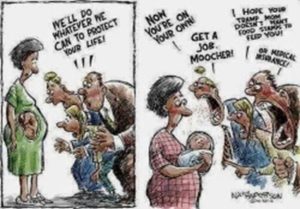
Carole Levine November 22, 2021
The verdict in the Kyle Rittenhouse case came as no surprise. We had watched the selection of an almost all white jury. We watched the antics and bias of Judge Bruce Schroeder as he ruled out key pieces of evidence for the prosecution and catered to the defense. Until the verdict came in we clung to the hope of a “guilty of something” verdict as the jury deliberated into its third day, but we were fools to do so. When the verdicts were read on Friday, and the now 18-year old who admitted to killing two men and critically wounding a third was found innocent on all counts, based on the claim he killed in self-defense, many of us were angry, sad, worried, and scared. But we were not surprised.
This verdict is part of a process that has been coming for a long time. We have seen the changes in our systems create greater and greater chasms between people. The gaps have grown between races and income as well as between those who are rural and those who are urban. We can look at recent history, starting with Ronald Reagan’s Presidency. When Reagan, in the 1980’s, insisted that cutting taxes would stimulate the economy, a pattern of the rich getting richer, the national deficit getting greater and domestic spending shrinking took hold. Reagan promised that cutting taxes would actually produce more revenue. His own Vice President, George H.W. Bush called this “voodoo economics,” but no one was complaining at the time. Those in power, and the wealthy were gaining wealth from these policies. It was during the Reagan years that the concept of the “Welfare Queen” was created. She was the no good parasite person that sucked up government monies from welfare programs, living a life of luxury. It was the Democrats who called for higher taxes and defense cuts to balance the deficit. Republicans accused them of being anti-business and soft on Communism.
According to Heather Cox Richardson: “The booming economy was paid for by extensive borrowing. During Reagan’s years in office, the federal debt tripled from $994 billion to $2.8 trillion, and America went from being a creditor nation to a debtor nation. Republican leaders insisted that the Democrats were responsible for the rising debt because they would not make sufficient cuts in domestic spending, but in fact increased defense spending meant the administration itself never submitted a balanced budget.”
Why look at this economic history when we are all worried about people walking around with guns on the streets? Why does this matter when people with guns can accuse folks who are peacefully gathered to protest, or to sing Christmas Carols or discuss issues at a school board meeting of making them feel threatened? What difference does it make if our country is in debt or has a balanced budget when we have to think twice about letting our children play group games or participate in organized sports lest someone feels their personal safety is at risk by the child (or his parent) who might just be armed to protect themselves? Things have changed since the Wisconsin jury in the Rittenhouse case agreed that then 17 year-old Kyle Rittenhouse had a right to defend himself and kill two people and wound a third because he felt they might harm him. Who will defend those two dead souls and the man Rittenhouse wounded? Were they not threatened by his AR 15 rifle? And they were white, just like Rittenhouse. So the chasm between them was not so much their own race as it was politics and what brought each of them to Kenosha that fateful evening. It was what they stood for.

We go back to the Reagan years because they truly were crucial in cementing the divisions between the “haves and the have-nots.” The economic policies of these times drove a wedge between those in need and those who could “pull themselves up by their bootstraps” and rise above their circumstances. There was a stigma about taking from the government and it was clear that it often had to do with who was “deserving” of support and who was not. And racism and sexism (since many in need were women) dominated the criteria of welfare and later anti-poverty programs. The association of the Welfare Queen in the public imagination linked poverty with criminality and stigmatized those who received public assistance. That myth continues today. And the gap has grown wider. It now plays out in our politics to the extent that the chasm between our “two-party system” no longer allows for bi-partisanship or shared values on issues. The right to self-defense will loom large in elections at all levels of government as we move forward from the Rittenhouse verdict. And closely linked to it will be a sense of criminalizing those who protest.
The Rittenhouse verdict will empower vigilantism. And that is a frightening notion. Where Republicans control statehouses, a range of laws are being passed that tamp down the First Amendment rights of protesters and raise up those who would take the law into their own hands (i.e., vigilantes). Writing for Slate, Tyler Valeska noted:
“Republican-controlled state legislatures have forged a comparable path on the policy front, enacting a rash of anti-protest legislation in recent years. Florida, Iowa, and Oklahoma granted immunity to drivers who run over protesters in certain circumstances, worrying advocates that extremists might mow down protests composed of marginalized groups and political enemies. A bevy of other states proposed but failed to pass similar legislation.
As government support for vigilantes grew, vigilante targeting of protesters exploded. Rallies and protests have been repeatedly canceled under looming threats of violence. By one count, militias and similar far-right actors showed up at approximately 500 protests last year, where they were responsible for 64 assaults, 38 cars driven into demonstrators, nine firings of guns at protesters, and 387 other instances of intimidation. There is reason to worry things will only get worse in the wake of Friday’s verdict.”
As our economy and our politics further widens the gaps between the “haves and the have-nots” and those gaps are seen along distinct racial and gender identity lines, the issues of self-defense and personal safety may become more and more wrapped in the politics of self-interest and in power structures at the local, state, and national levels. While there are seemingly options for protecting the right to peacefully assemble, both to protest and just to hold regular meetings and gatherings, those options vary from state to state and depend on the whims of local officials to use and enforce them.
We can take some comfort from two court decisions handed down this week. In Charlottesville, Virginia a jury awarded more than $26 million in damages finding all of the White nationalists who organized and participated in a violent 2017 rally in that city liable on a state conspiracy claim and other claims. “Today’s verdict sends a loud and clear message that facts matter, the law matters, and that the laws of this this country will not tolerate the use of violence to deprive racial and religious minorities of the basic right we all share to live as free and equal citizens.” said defense attorney Roberta Kaplan. The second decision was the guilty verdicts against the three White men accused in the death of Ahmaud Arbery, a Black man, in Brunswick, Georgia. In this case, Arbery was pursued by the men in their pickup trucks as he jogged through their neighborhood. They claimed they were attempting a “citizen’s arrest,” a carry over from slavery times when escaped enslaved peoples would be pursued and arrested. The jury that convicted the three was made up of 11 white jurors and one Black juror. John Perry, a Black pastor and former president of Brunswick NAACP chapter said of the verdict: “Our system isn’t perfect, it’s in need of a lot of tweaking, but this proves that it’s not totally broken.”
So, there’s some hope, amid some limited options. Another option is to prevent militia and extremist groups from bringing guns to protests. Just the presence of guns is a trigger (no pun intended) for trouble. But different states, again, have different laws about carrying firearms, both openly and concealed. And sometime this spring, the Supreme Court will rule on a case from New York that could make things more difficult to regulate.
The bottom line is that we should be worried about the growing support for vigilantism. It may not always be 17-year-olds with AR-15’s at an anti-police protest. It could be the angry anti-vaxer coming to shut down a vaccination clinic for 5 to 11-year-olds. Or it might take the form of an organized group of mothers that don’t like the books in the school library. Will they be carrying guns to the school board meeting? Will they be accompanied by the Proud Boys? It might depend on where you live. We also need to understand the growing feeling in the Black and Brown communities that they, too, will need to arm themselves and use guns for their own self-defense. If they are not feeling protected by the police in their communities, do they also become vigilantes? And will they receive the same deference as a Kyle Rittenhouse? Erwin Chemerinsky, Dean of the University of California at Berkeley School of Law in writing about the Rittenhouse verdict put the issues very clearly when he wrote:
“Our country is more deeply divided than it has been at any time since the Civil War. On Jan. 6, we witnessed an armed insurrection at the nation’s Capitol. In this context, others may well feel emboldened to emulate Rittenhouse, and that can only lead to more tragedies. […]
There will be many tense public events, including protests, in the years ahead. The presence of guns, let alone assault weapons, in such situations is something we should all fear. No one brings a firearm to a protest to further civil discourse. As the Rittenhouse case shows, it is all too easy for the presence of guns to encourage the packing of more guns — with armed violence and death as a result. The tragedy in Kenosha could have been avoided. Sometimes the law really ignores common sense.”
